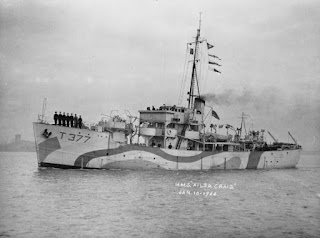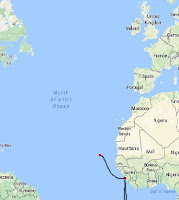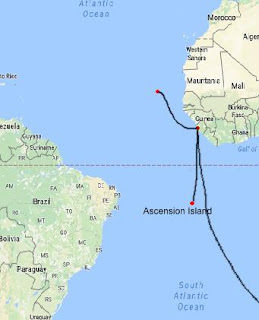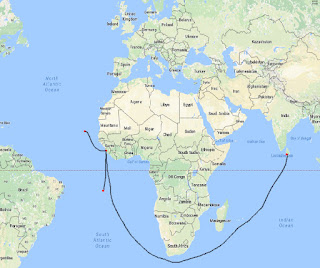I and a mate were transferred onto HMT "Oxna" at Freetown in August 1944. HMT "Oxna" was a fairly new Isles Class Trawler Minesweeper and had arrived at Freetown escorting a Liverpool to Freetown (Route OS) convoy.
Isles Class Minesweepers
Displacement: 545 tons. Complement : 40Dimensions: 164ft (50m) (oa) x 27.5ft (8.4m) x 10.5 ft (3.2m)
Propulsion: 1-shaft Reciprocating (VTE*); 850 IHP; 12 knots
Armament: 1- 12 pdr (76mm) A.A**; 3 – 20mm (Oelikon) A.A**;
30 Depth Charges
*VTE: Vertical Triple Expansion; ** A.A.: Anti-aircraft
Of the 145 Isles class minesweepers built, 13 were lost during World War II.
 |
| HMT "Ailsa Craig", sister ship to HMT "Oxna" © IWM (FL 292) |
HMT Oxna (T296)
Minesweeper Trawler of the Isles ClassPennant: T296
Builder: A & J Inglis Ltd., Glasow. Aitchison Blair.
Ordered : 16 June 1941; Laid Down: 22 April 1942;
Launched: 26 Jan 1943
Commissioned : 22 May 1943
Commanders:
T/ A / Lt. Cdr. Stephen Sparrow RNVR; April 1943 – Jan 1945
T / Lt. Matthew Mitchell RNVR; Jan 1945 – Mid 1945
The "Oxna" was built for minesweeping or escort duties. We had the anti-aircraft guns and depth charges since it was known that U-boats operated off the West African coast. I reported to a Patrol Service Gunlayer (PSG).
The Isles class minesweepers were excellent sea-craft and could stay out in all weathers even when larger vessels such as frigates would be seeking shelter. A far cry from HMS "June Rose" in terms of relative comfort.
We had our first long journey – to Cape Verde Islands out in the mid-Atlantic.

This group of islands needed to be visited in case the enemy set up a base there. The locals were always very helpful with information about the area. That ten days away from Freetown was uneventful.
Back in Freetown harbour, after a time it got boring, so the ship’s company was pleased when we got the order to sail to Ascension Island in the South Atlantic.
As this was my first journey across the equator, I was shaved by King Neptune in the traditional way.
Ascension Island had become a major airbase (Wideawake Airfield) for the United States military. They had used it in the North African campaign 'Operation Torch' and by 1944 it was used to refuel transport and cargo planes on journeys from North America to the Far East via Africa.
Our mission was to take a top American Marine commander to the island, although he could have flown there more quickly. One rumour was that he wanted to make a secret study of the island as a potential training ground for troops in preparation for the expected invasion of Japan. We did not stay very long in that isolated outpost and returned to Freetown.
Towards the end of 1944, there was an increase in convoys destined for the Far East and soon our crew was told to prepare for transfer to Ceylon (now called Sri Lanka) in the Indian Ocean.
There was a great deal of relief that we were leaving, as tropical diseases were rife amongst the military stationed in Sierra Leone. We were transferred to a troopship anchored in the harbour and were on our way, with no regrets, via the Cape of Good Hope.


